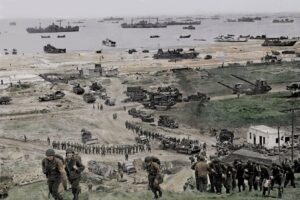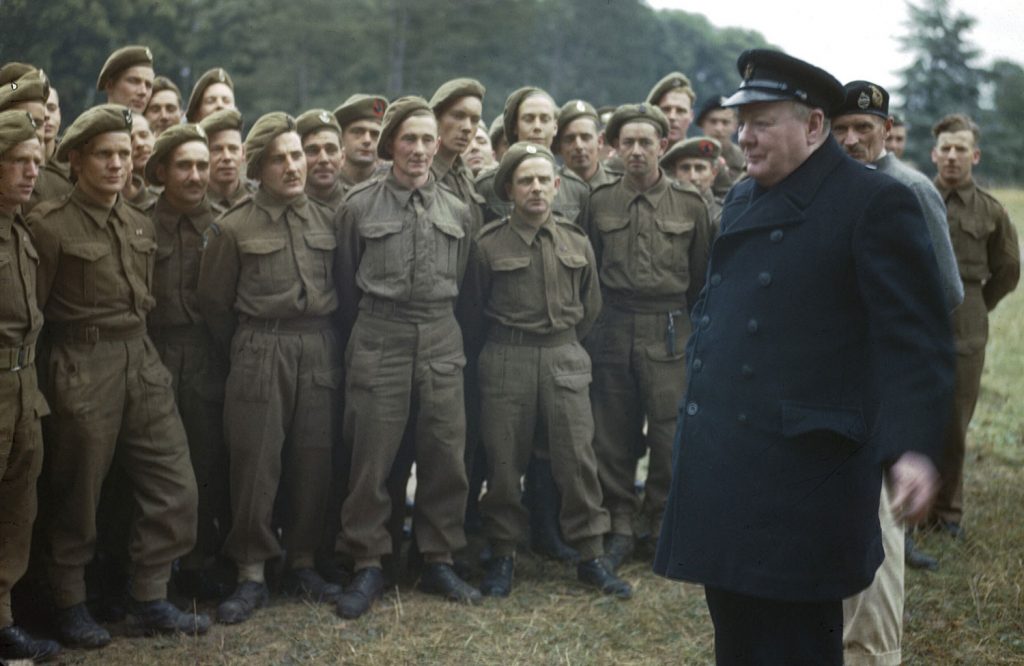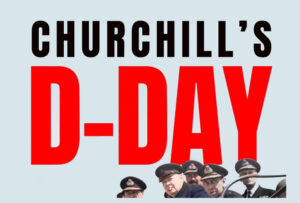
Finest Hour Extras
“Churchill and Roosevelt: The Struggle over D-Day Alternatives”

The Prime Minister, the Rt Hon Winston Churchill, MP, with men of the 50th Division who took part in the D-Day landings. Behind the Prime Minister is General Sir Bernard Montgomery. Image was created and released by the Imperial War Museum on the IWM Non Commercial Licence. Malindine E G (Capt), No 5 Army Film and Photographic Unit.
June 3, 2019
By Edward E. Gordon and David Ramsey
The special relationship between Great Britain and the United States was key to the development and execution of the Normandy campaign. It began with the close collaboration of Prime Minister Winston Churchill and President Franklin D. Roosevelt even before America’s entrance into the war. During 1940 and 1941 the two countries developed very close ties as German victories threatened all of Europe. Their joint military and logistical planning foreshadowed their ultimate alliance.1
The Debate Begins
D-Day’s seeds were first planted on Dunkirk’s beaches. Almost from the day in 1940 when the British and French forces were evacuated from France, the British began to consider where, when, and how they would return to free northwestern Europe from Nazi occupation. Much of this speculation was premature. Only when the United States dropped its neutrality would the combined manpower and firepower of Britain and America be available to guarantee the success of such a massive amphibious invasion of northwestern Europe. However, it still remained very difficult for the Allies to decide on when and where to launch this invasion.
Soon after Japan’s surprise attack on Pearl Harbor on 7 December 1941, Britain’s Prime Minister Winston S. Churchill called Franklin D. Roosevelt. “Mr. President, what’s this about Japan?” “It’s quite true he replied…. We are all in the same boat now.” Churchill immediately proposed travelling to Washington D.C. so that “We could review the whole war plan in the light of reality.” On 14 December 1941, he left for America. Churchill spent Christmas with Roosevelt as his guest at the White House.2

2025 International Churchill Conference
In their wide-ranging discussions, Roosevelt and Churchill made several unprecedented decisions that had a broad impact on future military operations. First, in order to unify Anglo-American strategy, they agreed that one Supreme Commander would be appointed in each theater of operations with final authority over all British/American land, sea, and air operations. Secondly, a new Combined Chiefs of Staff based in Washington, D.C., would be appointed with representatives from the British and American chiefs of staff to coordinate joint strategic military decisions. They also decided that the Allies should be called the “United Nations” instead of “Associated Powers.”3
Achieving this complete unification of military operations proved to be easier said than done. It set the stage for the future Allied invasion of France to become an enormous friction-filled event extending to the war’s final conclusion.
Why Are We Trying To Do This?
From the first day of the war, America’s leaders were determined to speedily confront and defeat the German army by invading northwestern Europe. But because the British had recently been decisively defeated by German forces at Dunkirk and in Norway and Greece, Churchill and the British Armed Forces Chiefs of Staff were much more cautious. They also remembered the slaughter of an entire generation in Flanders field battles of the Somme and Passchendaele during the First World War. As Winston Churchill recounted,
While I was always willing to join with the United States in a direct assault across the Channel on the German sea-front in France, I was not convinced that this was the only way of winning the war, and I knew that it would be a very heavy and hazardous adventure. The fearful price we had to pay in human life and blood for the great offensives of the First World War was graven in my mind.4
Britain’s war leaders also harbored grave doubts about the battle readiness of U.S. soldiers and thought that American generals lacked combat experience. From December 1941 to June 1944 this British foreboding cast a pall over the very idea of mounting a successful cross-channel invasion. “Why are we trying to do this?” Churchill was shouting even as late as February 1944. Almost up to the day of the actual Normandy landings, Churchill continually bombarded the Americans and his own generals with alternatives such as invading Norway, Portugal or the Balkans. This continued insistence on these diversionary maneuvers weakened his relationships with the American commanders.5
The British Chief of the Imperial General Staff, Sir Alan Brooke, voiced similar doubts about a Normandy invasion. Overall, Brooke did not believe that the Wehrmacht would be sufficiently weakened before 1944. Furthermore, he doubted that US war production would be able to turn out the huge quantity of goods required for an invasion and that America could train an adequate number of troops before this date.6
In spite of the Pearl Harbor debacle and the growing number of Japanese victories across the Pacific, the US government reaffirmed its prewar policy of defeating Germany first. To the relief of the British, both President Roosevelt and General George C. Marshall, the Chief of Staff of the US Army, acknowledged that Germany’s war-making capacity was far more dangerous. They agreed that Japan’s defeat would soon follow the collapse of the Third Reich. The most contentious issue between Britain and America became how to best defeat Germany.7
Operation RANKIN was the British chiefs of staff plan to implement this peripheral strategy with attacks in the Mediterranean region, the Balkans, Norway, and elsewhere. These thrusts would help to wear down the Nazi empire in Europe until it collapsed. Perhaps it was all wishful thinking on their part, but as late as November 1943, the British chiefs still considered the possibility of implementing RANKIN as an alternative to a major landing in Normandy.
In June 1942, Churchill persuaded Roosevelt to issue a joint veto for an Allied landing in France. Instead, Alan Brooke offered his own plan, Operation GYMNAST, a joint Anglo-American invasion of French North Africa.
Marshall and Admiral Ernest J. King, Chief of Staff of the US Navy, were angry at being forced by Roosevelt to commit to GYMNAST. This was one of the few times during World War II that Roosevelt intervened in a military decision. Marshall and King perceived it as a “sideshow” operation in the Mediterranean much more aligned with British Imperial interests than Allied strategic goals.8
Much the Greatest Thing
At the Casablanca Conference (January 1943), the British were able to secure the postponement of a cross-channel attack and substitute an agreement to mount Operation Husky, the invasion of Sicily. To appease the Americans, Churchill suggested appointing a commander for the invasion of northwestern Europe. He proposed that a member of the British Chiefs of Staff be named as a temporary deputy commander.
Marshall liked the idea. While Churchill thought this was a harmless consolation prize, Marshall perceived that appointing a deputy commander or a chief of staff gave the invasion planning a new lease on life. On 22 January 1943, the Combined Chiefs of Staff ordered the appointment of the British Lieutenant General Frederick Morgan and American Brigadier General Ray Barker as his deputy.9
Morgan assembled an Anglo-American staff that became known as COSSAC, taken from the first letters of his new title (Chief of Staff to the Supreme Allied Commander). They were to complete a detailed invasion plan by 1 August 1943. At that point, the plan needed a new code name. The British Inter Service Security Board had the role of assigning clearly differentiated names for each of the numerous Allied operations then underway. Unfortunately, the only name available was “MOTHBALL.”
When Morgan presented Operation MOTHBALL to Churchill, he went right through the roof. “Do you mean to tell me that those bloody fools want our grandchildren 50 years from now to be calling the operation that liberated Europe Operation Mothball? If they can’t come up with a better code name for our landing than that, I damn well will pick the code name myself.” Morgan said that Churchill “glowered for a moment” and then shouted, “Overlord. We shall call it Overlord.”10 That is how the greatest D-Day of them all came to be known to posterity as Operation Overlord. It was one of Churchill’s most important personal contributions to the invasion plan.
After World War II ended, Morgan wrote to British historian Liddell Hart about these and many other issues he faced during COSSAC’s lifespan. One of his most unsettling comments might help us better understand some of the Normandy campaign’s command dilemmas. Morgan observed that as the size of the US commitment to Overlord grew in manpower, aircraft, ships, etc., so did the signs that the British were developing an inferiority complex. He thought that this situation was “frightening.”11
During the autumn and winter of 1943, preparation for Overlord advanced. Yet behind the unified Allied front, the British grew increasingly apprehensive. In a cable to Marshall, Churchill stated, “We are carrying out our contract, but I pray God it does not cost us dear.”12
On 11 November, a British Chiefs of Staff memo recorded, “We must not regard Overlord on a fixed date as the pivot of our whole strategy … The German strength in France next Spring may … be something that makes Overlord impossible [or] Rankin not only practicable but essential.”13
At about the same time, Churchill wrote to Roosevelt, cautioning him that, “It is arguable that neither the forces building up in Italy [the Allied landing occurred in September 1943] nor those available for a May OVERLORD are strong enough for the tasks set them.” Churchill added his strongest objection to a cross-channel attack. “My dear friend, this is much the greatest thing we have ever attempted, and I am not satisfied that we have yet taken the measures necessary to give it the best chance of success.”14
Overlord Decision Point
The British finally had driven the Americans to their breaking-point. Roosevelt and Marshall were determined to force the British into a final non-revocable commitment to Overlord.
This opportunity presented itself at the Teheran Conference in Iran (28 November-1 December 1943). This was the first joint meeting of the “Big Three” – Joseph Stalin, Winston S. Churchill and Franklin D. Roosevelt.
Stalin was impatient for major military relief on the Eastern Front through the long-promised Anglo-American second front in France. The Tehran Conference gave Stalin and his generals a chance to pin down Churchill on his OVERLORD commitment.
At Teheran, the Allies finally agreed to an OVERLORD launch date sometime in May 1944 and a supporting operation in the south of France. The naming of the supreme commander was promised in the near future. On 7 December, Roosevelt broke the news to General Eisenhower that he was to be appointed to this position.
Churchill had been backed into a corner by the Russians and Americans and finally ran out of maneuvering room. Major General John Kennedy, a British planner, later conceded, “Had we had our way, I think there can be little doubt that the invasion of France would not have been done in 1944.”15
Even after the Tehran Conference, Churchill tried to get OVERLORD postponed for some more assaults “around the ring.” In April 1944, he told an American general that if he were planning OVERLORD, it would not be executed until the Allies had retaken Norway, invaded the Aegean islands, and secured Turkey’s support.16
After interminable delays, all the Allies finally accepted the OVERLORD concept. The die was cast! It had been a hard, bruising process.
Result: Pursuit of a Common Goal
Churchill sought to maintain Britain’s dominant position in Europe, preserve her colonial empire, and contain the menace posed by Soviet expansionism in Eastern Europe. American leaders did not foresee the post-war power struggle in Europe created by the rapid resurgence of the Soviet Union from horrendous war losses and the weakened ability of Britain and its allies to cope with this Communist threat.
The Americans were not naïve. They understood the political reasoning behind Churchill’s war policies. But, if these did not accomplish America’s military interests, the US chiefs of staff would not support them.17
Due to American political exigencies, Roosevelt and the US chiefs of staff sought to avoid a protracted war in Europe and to pursue a swift victory over Japan. US political and military leaders demanded the quickest and least costly road to victory. General George C. Marshall summarized this scenario when he said, “a democracy cannot fight a Seven Years War.”18
Here, two fundamentally opposing conceptions of war – the indirect versus direct approach – collided. For the British an invasion of northwestern Europe would come only as a final knockout blow. First, the German Wehrmacht had to be worn out by fighting on many fronts. The Americans contended that the Allies should be using the Clausewitzian principle of concentration of their forces at the decisive point. Their dispute was never resolved and repeatedly hampered the successful course of the Normandy campaign and the onset of the Cold War in Europe.19
Yet even with these limitations, the combined Allied Supreme Headquarters Allied Expeditionary Force (SHAEF) that planned and executed Operation OVERLORD contrasted sharply with the confused German (OKW) armed forces high command. “Alongside the command structure of their enemies, that of the Allied Force was a masterpiece of reason and understanding,” asserts historian Max Hastings.20
The pursuit of a common goal – the defeat of the Axis at times held a difficult partnership together. The “sheer depth, scale and scope of the alliance,” says Niall Barr, “between Britain and the United States … is hard to comprehend even now.”21
In the final analysis, Churchill highlighted why the Allies achieved the final victory through the OVERLORD campaign. “There is only one thing worse than fighting with allies, and that is fighting without them!”22
Edward E. Gordon and David Ramsay are co-authors of Divided on D-Day: How Conflicts and Rivalries Jeopardized the Allied Victory at Normandy (Prometheus Books, 2017).
Endnotes
1. Edward E. Gordon and David Ramsey, Divided on D-Day: How Conflicts and Rivalries Jeopardized the Allied Victory at Normandy (Amherst, NY: Prometheus Books, 2017), p. 321.
2. Martin Gilbert, Finest Hour: Winston S. Churchill, 1939-1941 (London: Heinemann, 1983), p. 1269.
3. Lynne Olson, Citizens of London (New York: Random House, 2010), p.149. Lewis E. Lehrman, Churchill, Roosevelt and Company (Guilford, CT: Stackpole Books, 2017), p. 279.
4. Winston S. Churchill, Closing the Ring, vol. 5, The Second World War (Boston: Houghton Mifflin Company, 1951), p. 582.
5. Max Hastings, Overlord: D-Day and the Battle for Normandy (New York: Simon and Schuster, 1984), p. 19. Lehrman, Churchill, Roosevelt and Company, p. 290.
6. David Fraser, Alanbrooke (Feldman, UK: Hamlyn Paperbacks, 1982), pp. 424, 528. Alan Brooke, War Diaries, 1939-1945, eds. Alex Danchev and Daniel Trodman (London: Phoenix Press, 2001), p. 554.
7. Gordon and Ramsay, p. 21.
8. Hastings, Overlord, pp. 22-25. William F. Moore, “Overlord: The Unnecessary Invasion,” Air War College Research Report (Maxwell Air Force Base, AL: Air University, US Air Force, March 1986), https://www.ibiblio.org/hyperwar/AAFNoOverlord/index.html (accessed April 4, 2017).
9. Hastings, Overlord, p. 21. Craig L. Symonds, Neptune: The Allied Invasion of Europe and the D-Day Landings (New York: Oxford University Press, 2014), p. 105.
10. Larry Collins, The Secrets of D-Day (Beverly Hills, CA: Phoenix Books, 2006), pp. 3-4. Frederick Morgan, Overture to Overlord (London: Hodder & Stoughton, 1950), p. 72.
11. Carlo D’Este, Decision in Normandy (Old Saybrook, CT: Konecky and Konecky, 1994), p. 38.
12. Quoted in Hastings, Overlord, p. 22.
13. Quoted in John Keegan, Six Armies in Normandy (New York: Penguin Books, 1994), p. 54.
14. Quoted in Robert Dallek, Franklin D. Roosevelt: A Political Life (New York: Penguin Books, 2017), p. 533.
15. John Kennedy, The Business of War (London: Hutchinson, 1957), pp. 301-305.
16. Samuel Eliot Morison, The Two-Ocean War: A Short History of the United States Navy in the Second World War (Atlantic Monthly Press, 1963), p. 385.
17. Gordon and Ramsay, Divided, pp. 322-323.
18. Quoted in Maurice Matloff, Strategic Planning for Coalition Warfare 1943-1944 (Washington, DC: Center of Military History, US Army, 1990), p. 5, http://www.history.mil/html/books/001/1-4/CMH_Pub_1-4.pdf (accessed June 4, 2017).
19. Symonds, Neptune, pp. 101-102. Correlli Barnett, Engage the Enemy More Closely: The Royal Navy in the Second World War (New York: W.W. Norton, 1991), p. 622.
20. Hastings, Overlord, p. 28.
21. Niall Barr, Eisenhower’s Armies: The American-British Alliance during World War II (New York: Pegasus Books, 2015), p. 1.
22. International Churchill Society, Chapters, 1 April 1945, https://winstonchurchill.org/resources/quotes/.
Subscribe
WANT MORE?
Get the Churchill Bulletin delivered to your inbox once a month.




